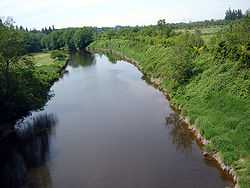Nicomekl River


The Nicomekl River springs from the ground in Langley, British Columbia and travels west through the city to Surrey's Crescent Beach, where it empties into Mud Bay, the northernmost section of the Boundary Bay of the Georgia Strait. It has a total length of 34 km, with a drainage area of 149 km2.[1] It is the last known bed of the native Pacific Coast Oyster in North America.[2]
History/Origins
The word Nicomekl is from the Halq'emeylem used by the Stó:lō people, meaning "the route to go" or "the pathway." The Nicomekl (Katzie) people, descendents of Smakwec, were largely wiped out by a smallpox epidemic in the 18th century.
Smakwec and his people, originating from Point Roberts, and their history, lands, resources, and culture were closely linked to those of the Katzie people. The descendants of Smakwec and his people are many, but many have vanished. The Nicomekl, as a distinct people, vanished in the time of the smallpox epidemic of the 19th century.[3]
The river was first documented in writing on December 13, 1824, when James McMillan's Hudson's Bay Company expedition to the Fraser River, travelled up the Nicomekl River. John Work, a clerk with the party, described the river as thick with willows and with low banks "well wooded with pine, cedar, alder and some other trees." Work also noted signs of there being numerous beavers on the river.[4]
Tributaries (listed from the mouth up)
- Chantrell Creek
- Anderson Creek
- Muckle Creek
- Pleasantdale Creek
- Langley Creek
- Newlands Brook
References
- ↑ "Ambient Water Quality Objectives for Boundary Bay and its Tributaries", Ministry of Environment and Parks, 1988.
- ↑ Nicomekl Information
- ↑ http://www.historylink.org/index.cfm?DisplayPage=output.cfm&File_Id=3176
- ↑ Bartroli, Thomas. Genesis of Vancouver City. Vancouver: (Self-Published). 1997.